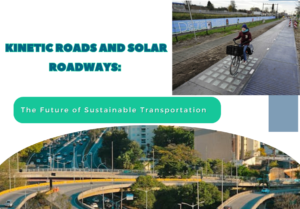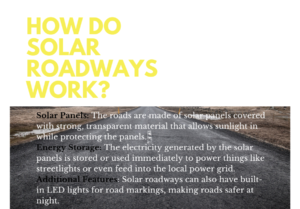Imagine a road that generates electricity while you drive on it. Sounds like something out of a sci-fi movie. Well, welcome to the future of sustainable transportation, where kinetic roads and solar roadways are turning that vision into reality. These innovative technologies have the potential to change how we think about infrastructure and energy, offering a greener and more efficient way to power our cities. Let’s dive into how these remarkable roads work and why they’re becoming so popular in this Blog “Kinetic Roads and Solar Roadways: The Future of Sustainable Transportation”.
What Are Kinetic Roads?
Kinetic roads are roads that capture energy from the movement of vehicles. When cars, trucks, or buses drive over these roads, the pressure from their weight is converted into electricity. It’s similar to how some watches are powered by movement—only much bigger! The technology uses sensors and special plates embedded in the road that generate energy whenever a vehicle passes over them.
How Do Kinetic Roads Work?
Kinetic roads use a combination of pressure plates, mechanical components, and energy conversion systems to generate electricity. Here’s a step-by-step breakdown:
Pressure Plates: Plates are embedded beneath the surface of the road. When a vehicle drives over them, its weight creates pressure, pushing down on the plates.
Mechanical Movement: This pressure causes a slight movement in the plates, which in turn drives a mechanical system (similar to how gears move).
Energy Conversion: The mechanical movement is then converted into electrical energy through a generator. This energy can be used immediately or stored for later use.
Different Technologies in Kinetic Roads
There are several ways kinetic energy can be harnessed on roads:
Piezoelectric Sensors: Piezoelectric materials generate electric charge when they are subjected to mechanical stress. Piezoelectric sensors embedded in the road can capture the energy produced when vehicles drive over them.
Speed Bumps with Energy Harvesters: In some systems, energy harvesters are built into speed bumps. As vehicles slow down and pass over these bumps, the pressure generates electricity, which can power nearby infrastructure like streetlights.
Benefits of Kinetic Roads
Renewable Energy Generation: Kinetic roads turn everyday vehicle movement into an opportunity to generate renewable energy. Unlike fossil fuels, this method doesn’t produce harmful emissions, making it an environmentally friendly option.
Efficient Use of Infrastructure: Kinetic roads use existing roadways, which means they don’t require additional land or space. They simply make the most of infrastructure that’s already there.
Energy Cost Savings: Cities can use the electricity produced by kinetic roads to power streetlights, traffic signals, or other public utilities, potentially lowering their energy bills.
What Are Solar Roadways?
Solar roadways are roads with solar panels embedded in them. These panels are designed to be durable enough to handle the weight of cars and trucks while capturing sunlight to generate electricity. Imagine driving on a road that looks like glass tiles, all working together to generate clean energy.
How Do Solar Roadways Work?
Solar Panels: The roads are made of solar panels covered with strong, transparent material that allows sunlight in while protecting the panels.
Energy Storage: The electricity generated by the solar panels is stored or used immediately to power things like streetlights or even feed into the local power grid.
Additional Features: Solar roadways can also have built-in LED lights for road markings, making roads safer at night.
Benefits of Solar Roadways
Clean Energy: Solar roadways harness the power of the sun, providing a renewable and environmentally friendly energy source.
Snow and Ice Melting: In colder climates, solar roadways can have built-in heating systems that melt snow and ice, reducing the need for road salt and making winter travel safer.
Multi-Functional: Besides generating electricity, solar roadways can provide lighting, traffic signals, and even electric vehicle charging points directly on the road.
Challenges Faced by Kinetic and Solar Roads
While kinetic roads and solar roadways are exciting innovations, they do come with challenges:
Cost: The materials and technology required to create these roads are expensive, which makes large-scale implementation a challenge.
Durability: Roads must endure heavy loads and extreme weather conditions. Developing a road that can handle these stresses while also generating energy is difficult.
Maintenance: Both technologies require ongoing maintenance, which can be costly and complex, especially in regions with harsh climates.
Countries Using Kinetic Roads and Projects
Italy:
Project Name: Lybra System – The Italian company Underground Power developed the Lybra System, which is installed in several locations across Italy. The system collects energy from vehicles braking at intersections. The energy generated is used to power streetlights or fed into the local power grid.
Netherlands:
Project Name: SolaRoad Bike Path – Although primarily a solar roadway, the Netherlands also experimented with kinetic tiles in walkways. The country is known for being an innovator in sustainable road technology. The SolaRoad project involves embedding kinetic tiles on paths to capture the energy from bicycles and pedestrians.
Countries Using Solar Roadways and Projects
France:
Project Name: Wattway – The Wattway project in Tourouvre-au-Perche, France, is the first large-scale solar roadway. The road spans about 1 kilometer and uses solar panels embedded into the road surface to generate electricity. The energy produced is used to power streetlights in the village.
United States:
Project Name: Solar Roadways Pilot Projects – In the United States, Solar Roadways Inc. has been leading the effort to develop solar roads. The company has installed pilot projects, including solar roads in parking lots and public spaces in states like Idaho and Missouri. The project aims to prove the feasibility of using solar panels to generate electricity and power lights, electric vehicle charging stations, and other utilities.
China:
Project Name: Jinan Solar Expressway – In Jinan, the capital of Shandong Province, a solar expressway was constructed in 2017. The expressway is a 2-kilometer stretch of road with solar panels installed beneath a transparent surface layer. The generated energy powers streetlights and can charge electric vehicles. China’s efforts show the potential for large-scale implementation of solar roadways.
Netherlands:
Project Name: SolaRoad – The SolaRoad project was launched in Krommenie, Netherlands, as the world’s first solar bike path. It’s a cycling path equipped with solar panels that generate electricity, which is then used for street lighting and residential power needs. The Netherlands has been at the forefront of using solar technology in public infrastructure.
India:
India is still in the early stages of experimenting with solar roadways. With a focus on renewable energy, the country has initiated some pilot projects to test the viability of solar roads.
Pilot Projects in National Highways: The National Highways Authority of India (NHAI) has been actively exploring the feasibility of using solar panels in road infrastructure. Though there are no major operational solar roadways as of now, some pilot projects are being considered, particularly along highways and expressways. These projects aim to integrate solar panels into sound barriers, bus shelters, and toll plazas rather than directly embedding them in roads.
Bengaluru Smart City Initiatives: Bengaluru, one of India’s leading technology hubs, has shown interest in smart city initiatives that include renewable energy integration. Solar roads could potentially become part of these initiatives, with the goal of utilizing solar panels to power streetlights and other roadside infrastructure.
- Solar Highways and Rooftop Panels
While India may not have fully implemented solar roadways yet, it has taken significant steps towards utilizing solar energy for infrastructure. Some of the developments include:
Delhi-Meerut Expressway: In 2021, a section of the Delhi-Meerut Expressway was lined with solar panels along its length. Though this is not a solar roadway in the traditional sense, it does showcase India’s effort to generate renewable energy alongside highways. The solar panels along the expressway generate electricity to power streetlights and other facilities, reducing the reliance on conventional energy sources.
Solar Rooftops at Toll Plazas: Another innovative use is the installation of solar rooftops at toll plazas across national highways. This approach generates electricity to power the toll facilities, including lights, fans, and electronic toll collection systems.
Future Potential in India
India’s interest in renewable energy and sustainable infrastructure is likely to drive further exploration and adoption of kinetic and solar road technologies. Given the country’s growing vehicle population and heavy traffic, kinetic energy harvesting systems have immense potential to produce energy efficiently. The government’s focus on electrifying transportation, including the promotion of electric vehicles, could also align well with the use of solar and kinetic roads to create charging stations for electric vehicles.
Feel free to follow us there on Instagram and drop a comment to say hello!


